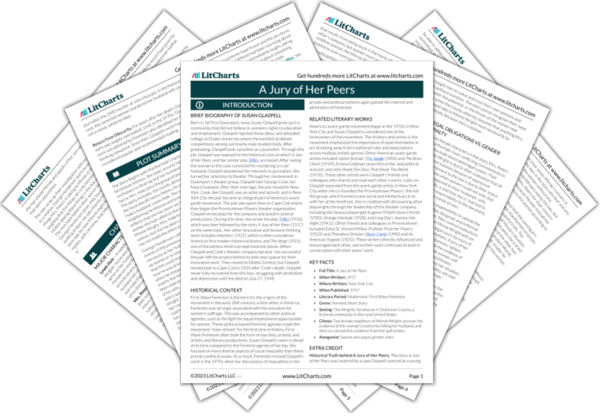The Subjugation of Women
In “A Jury of Her Peers,” men and women have distinctly different gender roles and the story portrays the different opportunities available to men and women both in terms of the division of labor and in society as a whole. This world is controlled by men because social rules restrict women’s ability to move about, to choose their own interests, or to exist as separate beings from their husbands. Minnie Wright and Martha Hale are…
read analysis of The Subjugation of WomenMale Obliviousness to Women’s Importance
While society and individual men oppress women throughout this short story, another theme in the text is the unexpected power the women have within the domestic sphere. This power is unexpected because the male characters repeatedly overlook the potential of the “trifles” that concern women. Ironically, the two women discover the evidence the men seek among the domestic items that the men dismiss. The men are unable to see the importance of the…
read analysis of Male Obliviousness to Women’s ImportanceLegal Obligations vs. Gender Loyalty
The two female characters in the story, Mrs. Peters and Martha Hale, have conflicting commitments to Minnie Wright and the male-dominated legal system. Their commitment to Minnie Wright is due to their realization that all women have experienced isolation because of oppressive gender roles. Their commitment to the law is due to their status as citizens, but also, at a time when women could not vote, due to their position as wives subjected to…
read analysis of Legal Obligations vs. Gender Loyalty
Crime and Punishment
The story begins like a murder mystery, in which evidence is sought to convict a culprit. A murder mystery examines a crime, which, when the criminal is caught, is appropriately answered with a punishment. However, in this story, the ideas about what constitutes a crime and how a punishment can or cannot account for a crime are made more complicated. The jury of Minnie Wright’s peers—Mrs. Peters and Martha Hale—judges her to…
read analysis of Crime and Punishment











